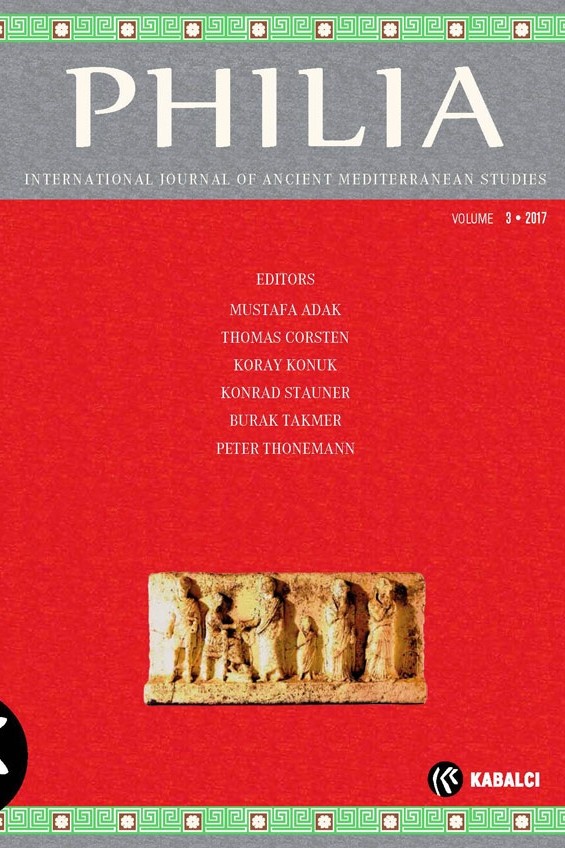Phrygia’dan Dionysos İçin Yeni Bir Adak Yazıtı
Dionysos, besleme, Dorylaion, Phrygia, adak yazıtı, Eskişehir Müzesi
Phrygia’dan Dionysos İçin Yeni Bir Adak Yazıtı
Dionysos, threptos, Dorylaion, Phrygia, votive altar, Eskişehir Museum,
___
- Armanet 1904 C. Armanet, Inscriptions de Dorylée, BCH 28(1), 1904, 191–200.
- Cole 1991 S. G. Cole, Dionysiac Mysteries in the Phrygia in the Imperial Period, EA 17, 1991, 41–49.
- Cameron 1939 A. Cameron, ΘΡΕΠΤΟΣ and Related Terms in the Inscriptions of Asia Minor, şurada: W. M. Calder – J. Keil (eds.), Anatolian studies presented to William Hepburn Buckler, Manchester 1939, 27–62.
- Domaszewski 1883 A. v. Domaszewski, Inschriften aus Kleinasien 1, AEMÖ 7, 1883, 168–188.
- Drew-Bear 1978 T. Drew-Bear, Nouvelles inscriptions de Phrygie, Zutphen 1978.
- Drew-Bear – Naour 1990 T. Drew-Bear – C. Naour, Divinités de Phrygie, ANRW II 18.3, 1990, 1907–2044.
- Drew-Bear et al. 1999 T. Drew-Bear – C. M. Thomas – M. Yıldızturan, Phrygian Votive Steles, Ankara 1999.
- Farnell 1909 L. R. Farnell, The Cults of the Greek States, Vol. 5, Oxford 1909.
- Frei 1990 P. Frei, Die Götterkulte Lykiens in der Kaiserzeit, ANRW II 18.3, 1990, 1729–1864.
- GIBM IV.1 The Collection of Greek Inscriptions in the British Museum, vol. IV.1: Knidos, Halikarnassos and Branchidae, ed. G. Hirschfeld, Oxford 1893.
- Göktürk 2000 M. T. Göktürk, Nümizmatik, Dionysos Kültü ve Şarap Kültürü, şurada: Anadolu Medeniyetleri Müzesi 1999 Yıllığı, Ankara 2000, 129–153.
- Graf 1985 F. Graf, Nordionische Kulte. Religionsgeschichtliche und Epigraphische Un¬ter-suchungen zu den Kulten von Chios, Erythrai, Klazomenai und Pho¬kaia, Roma 1985.
- Haspels 1962 C. H. E. Haspels, Relics of a Dionysiac Cult in Asia Minor, AJA 66.3, 1962, 285–287.
- Haspels 1971 C. H. E. Haspels, The Highlands of Phrygia. Sites and Monuments, Princeton 1971.
- Held 2003 W. Held, Neue revidierte Inschriften aus Loryma und der karischen Cher¬sones, EA 36, 2003, 55–86.
- Kaygusuz 1984 İ. Kaygusuz, Inscription of Kimistene, EA 4, 1984, 69–72.
- Kerényi 2004 C. Kerényi, Dionysos: Yok Edilemez Yaşamın Arketip İmgesi, (çev. Bahar Çeti-ner), İstanbul 2013.
- Kern 1905 O. Kern, Dionysos, RE 5, 1905, 1010–1046.
- Körte 1900 A. Körte, Kleinasiatische Studien VI (Inschriften aus Phrygien), MDAI(A) 25, 1900, 398–444.
- LGPN V A Th. Corsten – R. W. V Catling – M. Ricl, A Lexicon of Greek Personal Names, Oxford 2010.
- Littmann 1916 E. Littmann, Lydian Inscriptions, Leiden 1916.
- Lochman 2003 T. Lochman, Studien zu kaiserzeitlichen Grab und Votivereliefs aus Phry¬gien, Basel 2003.
- MAMA V C. W. M. Cox – A. Cameron (edd.), Monumenta Asiae Minoris Antiqua V: Monuments from Dorylaeum and Nacolea, Manchester 1937.
- MAMA VI W. H. Buckler – W. M. Calder (edd.), Monumenta Asiae Minoris Antiqua VI: Monuments and Documents from Phrygia and Caria, Manchester 1939.
- MAMA IX B. Levick – S. Mitchell – J. Potter – M. Waelkens (edd.), Monumenta Asiae Minoris Antiqua IX: Monuments from the Aezanitis, Londra 1988.
- Merkelbach 1988 M. Merkelbach, Die Hirten des Dionysos, Stuttgart 1988.
- Nani 1943/44 T. G. Nani, ΘΡΕΠΤΟΙ, Epigraphica V-VI, 1943/44, 45–84.
- Naour 1980 Chr. Naour, Tyriaion en Cabalide. Épigraphie et géographie historique, Zutphen 1980.
- Nilsson 1941 M. P. Nilsson, Geschichte der griechischen Religion I: Bis zur griechischen Weltherrschaft, Münih 1941.
- Nilsson 1950 M. P. Nilsson, Geschichte der griechischen Religion II: Die hellenistische und römische Zeit, Münih 1950.
- Nilsson 1957 M. P. Nilsson, The Dionysiac Mysteries of the Hellenistic and Roman Age, Lund 1957.
- Otto 1965 W. F. Otto, Dionysus: Myth and Cult, Bloomington 1965.
- Öztürk 2010 B. Öztürk, Yazıtlar Işığında Roma İmparatorluk Çağı Küçükasyası’nda Diony¬sos Kültü, İstanbul 2010.
- Prott 1902 H. v. Prott, Dionysos Kathegemon, MDAI(A) 27, 1902, 161–188.
- Ricl 1994 M. Ricl, Inscriptions votives inédites au musée d’Eskişehir, Živa Ant. 44, 1994, 157–174.
- Ricl 1995 M. Ricl, Les ΚΑΤΑΓΡΑΦΑΙ du sanctuaire d’Apollon Lairbenos, Arkeoloji Der-gisi 3, 1995, 167–195.
- Ricl 2001 M. Ricl, Donations of Slaves and Freeborn Children to Deities in Roman Macedonia and Phrygia: A Reconsideration, Tyche 16, 2001, 127–160.
- Ricl 2005 M. Ricl, Legal and Social Status of θρεπτοί and Related Categories in the Greek World: The Case of Phrygia in the Roman Period, Νεοελληνική κληρονομία στοΰς Σέρβους Α′ (Neohelensko nasledje kod Srba I), 2005, 145–166.
- Ricl 2006 M. Ricl, Legal and Social Status of θρεπτοί and Related Categories in the Greek World: The Case of Lydia in the Roman Period, Recueil de travaux de la Faculté de philosophie série A: Les sciences historiques vol. XX: Sobria Ebrietas: Mélanges offerts à Miron Flasar, 2006, 293–321.
- Ricl 2009 M. Ricl, Legal and social status of threptoi and related categories in narrative and documentary sources, şurada: H. Cotton et al. (eds.), From Hellenism to Islam: Cultural and Linguistic Change in the Roman Near East, Cam¬bridge 2009, 93–114.
- Schlesier 2011 R. Schlesier (ed.), A Different God? Dionysos and Ancient Polytheism, Berlin–Boston 2011.
- Seaford 2006 R. Seaford, Dionysos, London-New York 2006.
- SERP Studies in History and Art in the Eastern Provinces of the Roman Empire, written for the quatercentenary of the University of Aberdeen by seven of its graduates, ed. William Mitchell Ramsay, Aberdeen 1906.
- Taşlıklıoğlu – Frisch 1975 Z. Taşlıklıoğlu – P. Frisch, New Inscriptions from Troad, ZPE 17, 1975, 101–114.
- Thonemann 2013 P. Thonemann, Households and families in Roman Phrygia, şurada: P. Thonemann (ed.), Roman Phrygia, Cambridge 2013, 124–142.
- Wilamowitz-Moellendorf 1922 U. von Wilamowitz-Moellendorf, Pindaros, Berlin 1922.
- Zgusta 1964 L. Zgusta, Kleinasiatische Personennamen, Prag 1964.
- ISSN: 2149-505X
- Başlangıç: 2015
- Yayıncı: Kabalcı Yayıncılık
Kappadokia Komana’sı Geç Roma Seramikleri
Havza’dan Yeni Bir Miltaşı Üzerinde Aradii Soyundan Yeni Bir Galatia Valisi: C. Aradius Rufinus
Kaunos Tiyatrosu’nun Klasik Dönem Sahne Binası
Diocletianus’un Aphrodisias’tan İ.S. 1/9/301 Tarihli Revalüasyon Fermanı Üzerine Notlar
İmparatorluk Dönemi’nde Perge Akropolis’i ve Kent için Önemi
Korykos’tan (Dağlık Kilikia) Bir Mezar Steli
Ionia Nif (Olympos) Dağı’ndan Sikkeler
Phrygia’da bir İmparator Azatlısı’nın Adak Yazıtı
